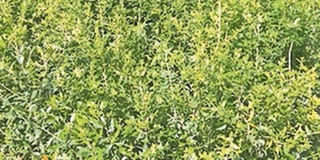Olive tree: A symbol of peace and hope that offers durable timber

African olive has great commercial value as it is used in production of construction beams, carvings, fencing posts, wood fuel, medicine and fodder. PHOTO | FILE | NATION MEDIA GROUP
What you need to know:
- The tree is propagated from seeds or hardwood cuttings. A kilogramme of its seeds costs Sh3,000 at Kefri shops.
- On average, a six-month-old seedling sells for Sh100 in the market while one that is a year old goes for up to Sh300.
- The tree can regenerate after a fire and produces oil for cooking, dressing salads, lighting and even anointing kings. The oil comes from its small oval fruits.
- A tea made from dried leaves is said to help improve kidney function and alleviate urinary tract problems.
Olea africana (African olive or wild olive) is one of the world’s oldest trees. It is a subspecies of the domesticated Olea europaea, which is grown in southern Europe and the Middle East, for production of olive oil.
The wild olive is widespread in Africa. It grows in many countries from South Africa to Ethiopia in the north, Somalia in the east and Sierra Leone in the west.
According to Kenya Forestry Research Institute's (Kefri) Guide to Planting Trees in Kenya, it grows in ecological zones with altitudes ranging from 1,600-2,200 metres above sea level.
These regions have annual rainfalls of between 800mm and 1,400mm. However, it is a drought-and-disease-resistant tree that can grow in zones with less rain, reaching heights of 18 metres and can live for up to 120 years, but matures in 30 years.
Its Kenyan names include Mutamaiyu (Kikuyu) and Kumutamaywa (Bukusu).
Propagation
The tree is propagated from seeds or hardwood cuttings. A kilogramme of its seeds costs Sh3,000 at Kefri shops.
The seeds should be soaked in hot water for at least 24 hours, according to the Seed Handbook of Kenya, edited by Omondi W, Maua JO, and Gachathi FN and published by Kefri.
They should be sowed in sandy soil and watered well once a week. This is a tree I have not tried to plant in the nursery, so I prefer buying seedlings.
On average, a six-month-old seedling sells for Sh100 in the market while one that is a year old goes for up to Sh300.
Once planted, the tree, which is resistant to most diseases, needs very little care. Indeed, because of its disease-resistant nature, it is used as the stock onto which the cultivated olive, Olea europaea, is grafted.
Like its cousin, this tree is a symbol of peace and hope. For those who have read the story of the floods in the Bible, it is a leaf of this tree that the dove sent by Noah brought back to show that the waters had abated off the earth, and that peace had been restored.
It is from this that the English idiom “To hold out the olive branch (to someone)” is derived. It means to extend an offer or gesture of peace, reconciliation or truce to end a disagreement or dispute. In the Bible, the olive tree is also referred to as a symbol of fertility and prosperity.
The tree can regenerate after a fire and produces oil for cooking, dressing salads, lighting and even anointing kings. The oil comes from its small oval fruits.
In Africa, the European olive grows mostly in the north of the continent, but some sub-Saharan countries, including Uganda, have tried to grow it.
Commercial value
African olive has great commercial value as it is used in production of construction beams, carvings, fencing posts, wood fuel, medicine and fodder.
It is further used to make some of the most durable and desirable beehives because the insects are attracted by the sweet scent of its wood. Its flowers are also sweetly-scented and bees love their pollen and nectar.
Among the Kikuyu, its green leaves when crashed and boiled were traditionally used for deworming. The smoke and ashes of its wood were also used to treat sour milk in gourds.
A tea made from dried leaves is said to help improve kidney function and alleviate urinary tract problems.
Leaf extracts are further used to treat eye infections, colic, sore throats, diarrhoea and fever and have reputedly been used to treat malaria by indigenous peoples.
Unlike its European cousin whose fruits produce oil, juice from ripe African olive is used as an ink. The fruit is enjoyed by birds, monkeys, mongoose and humans.
The flowers attract bees, butterflies and insects, while the leaves also make an excellent fodder for livestock.
The wood, which has a reddish or golden brown colour, is strong, durable and extremely hard. It is popular with carpenters, particularly for furniture and cabinet making.
When used as fence posts or house construction, it lasts for long because it is resistant to termites, borers and rot.
As charcoal and firewood, it is economical because it burns for long just like that of the Acacia xanthophloea.
There is just one disadvantage.
Olea africana, like grevillea, has an aggressive root system. While this helps in controlling soil erosion, it is not advisable to plant it near buildings and walls.




